Mobile Menu

About Us
Charter Oak Winery is a gem of Napa Valley. Like many other wineries in the valley it began as a small family operation. While it’s grown since its founding in the early 20th century by Italian immigrant Guido Ragghianti, Charter Oak is still family run, by Guido’s grandson Robert Fanucci, who continues to use much of Guido’s original equipment and techniques today.
CLICK HERE TO VIEW THE CHARTER OAK PHOTO ALBUM
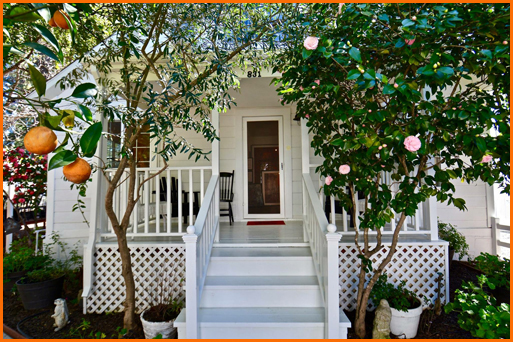 |
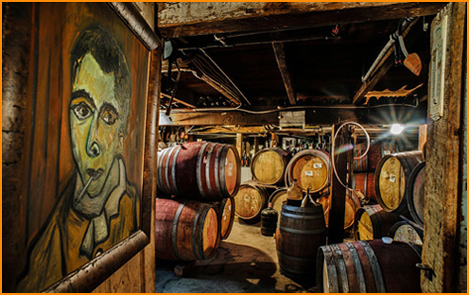 |
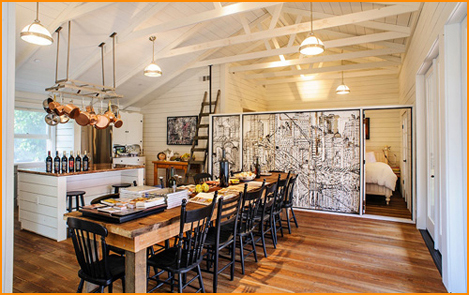 |
How it began
My earliest memories of my grandfather Guido Ragghianti were in the fields and vineyards surrounding his home in St. Helena on Charter Oak Avenue picking and crushing grapes. My first memory of wine was seeing crushed grape s in a large, wooden fermentation tank. I was mesmerized by the color, smell, and taste of the crushed grapes. I distinctively remember putting my fingers in the grape must a licking the luscious grape juice from my fingers. It seemed as if I had spent hours doing this on one particular afternoon and as I reflect back, I was lucky that the juice had not yet fermented – otherwise I would have been one little sick Italian boy! I also remember receiving sweet wine from my grandfather when I was just age 4. The only present I would receive would be a bottle of sweet wine which had a white string around the top. On my birthday, I was offered a sip, and the bottle would mysteriously disappear once my grandfather left our house. As a young child, even at the age of four or five, my grandfather would always allow me to drink wine at the table which was diluted with water. This is referred to as Aqua Con Vino (water with wine). My grandfather also made grappa from grapes grown on his property in St. Helena on Charter Oak Avenue. He would also dry out the Italian prunes in the hot St. Helena sun, which were also grown on the property as well as grapes and soak them in the grappa. Again, at an early age, I was exposed to brandied prunes and brandied grapes. I remember when I was 8 years old going to a restaurant and seeing prunes on the menu. I quickly ordered the prunes when the waitress came to our table. I was very disappointed when I tasted the prunes since they did not taste anything like the brandied prunes that I would devour at my grandfather’s table. My grandfather drank wine every day of his life, but only with meals. He would never drink unless he was eating lunch or dinner. He would always admonish me never to drink unless I was eating. Of course, my grandfather never spoke English, so all of my training was in Italian. Alto Mangia, Beve
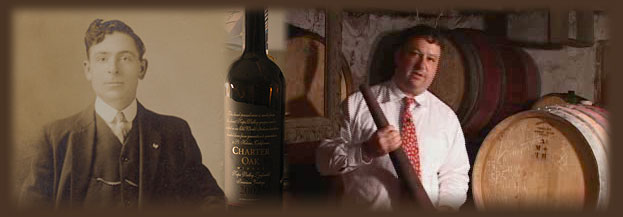
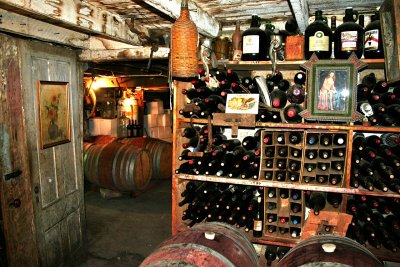
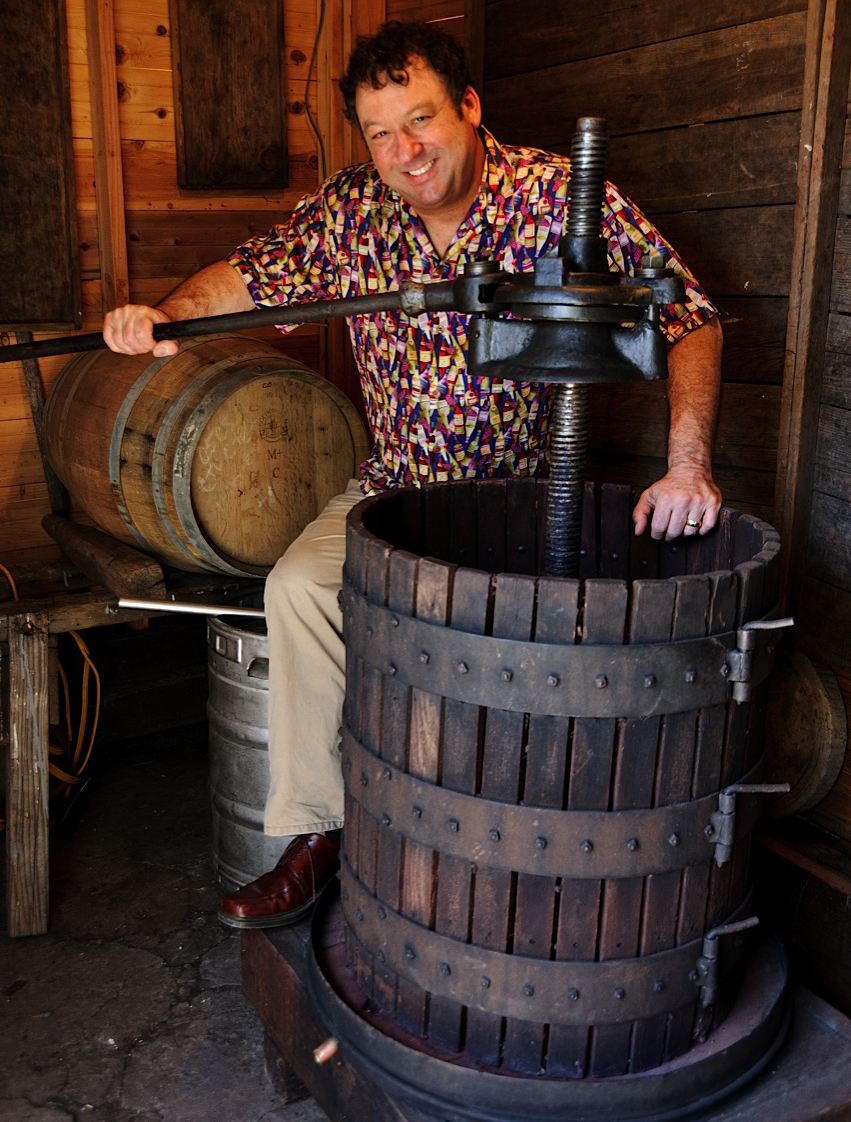

1) Guido at his basket press
2) With his wife, Matilda Ragghianti
3) With his son-in-law Gildo Fanucci
4) Guido's grandson, Robert Fanucci
My grandfather as well as my grandmother, Matilda Ragghianti, were both excellent chefs. The table was always full of food and there was always five to seven vegetables, three to four different meat dishes, at least two pasta dishes, fruit, cheeses, a variety of wines, and, of course, grappa, at the end of a meal. As a young boy, I helped my grandfather make wine by assisting in the picking and crushing of grapes.
However, it wasn't until 1986 when I had lost my job at a securities firm and was living off a 6-month severance that I had learned the winemaking process from start to finish. Coincidentally, in the harvest of 1986, my grandfather died a peaceful death at age 98. From the vintage of 1986, I fell in love with wine as well as the winemaking process.
I was fortunate to inherit all of my grandfather's winemaking tools and equipment, including a 100-year old basket press, home-made punch-down tools, which my mother (Lola Ragghiantti Fanucci) says are at least 100-years old, as well as barrels, funnels, a hand-grape crusher, 5-gallon containers, 1-gallon glass jugs, siphon hoses, wooden bungs and an assortment of other tools and equipment.
The wine was fermented in an old chicken coop in the back of my grandfather's property on Charter Oak Avenue. Underneath his house was an old European wine cellar, where the wine was barrel-aged. In the early ‘20s and thereafter, he bartered wine from his basement.
How Charter Oak is still made today
Charter Oak wine is unfined and unfiltered. The grapes are fermented on natural yeast. I use tools crafted by my grandfather (Nonno in Italian) to punch down the cap three times a day. I work the must into a foaming lather. No one makes wine quite this way. We believe the secret to our success is the natural fermentation and the punch down of the cap with hand-made wooden tools, which is done religiously over and over. There is nothing quite as beautiful than to see the sun shining down on the purple grape juice as it bubbles to the top. I live for this and it nourishes my soul.
After three to four weeks in the fermentation tank, it is time to separate the skin from the juice. This is all done by hand by utilizing the 100-year old basket press. The wine is then bucketed into barrels. This is certainly not the most efficient way of making wine but follows my grandfather's winemaking tradition. The wine is in the truest sense handcrafted. We guarantee that you can taste the difference in every bottle of our wine in comparison to mass-produced wines.
However, it wasn't until 1986 when I had lost my job at a securities firm and was living off a 6-month severance that I had learned the winemaking process from start to finish. Coincidentally, in the harvest of 1986, my grandfather died a peaceful death at age 98. From the vintage of 1986, I fell in love with wine as well as the winemaking process.
I was fortunate to inherit all of my grandfather's winemaking tools and equipment, including a 100-year old basket press, home-made punch-down tools, which my mother (Lola Ragghiantti Fanucci) says are at least 100-years old, as well as barrels, funnels, a hand-grape crusher, 5-gallon containers, 1-gallon glass jugs, siphon hoses, wooden bungs and an assortment of other tools and equipment.
The wine was fermented in an old chicken coop in the back of my grandfather's property on Charter Oak Avenue. Underneath his house was an old European wine cellar, where the wine was barrel-aged. In the early ‘20s and thereafter, he bartered wine from his basement.
How Charter Oak is still made today
Charter Oak wine is unfined and unfiltered. The grapes are fermented on natural yeast. I use tools crafted by my grandfather (Nonno in Italian) to punch down the cap three times a day. I work the must into a foaming lather. No one makes wine quite this way. We believe the secret to our success is the natural fermentation and the punch down of the cap with hand-made wooden tools, which is done religiously over and over. There is nothing quite as beautiful than to see the sun shining down on the purple grape juice as it bubbles to the top. I live for this and it nourishes my soul.
After three to four weeks in the fermentation tank, it is time to separate the skin from the juice. This is all done by hand by utilizing the 100-year old basket press. The wine is then bucketed into barrels. This is certainly not the most efficient way of making wine but follows my grandfather's winemaking tradition. The wine is in the truest sense handcrafted. We guarantee that you can taste the difference in every bottle of our wine in comparison to mass-produced wines.

Fanucci Family
hand-crafting their wines-
Robert, Layla, Nicole, Michelle, and David Fanucci.
hand-crafting their wines-
Robert, Layla, Nicole, Michelle, and David Fanucci.
